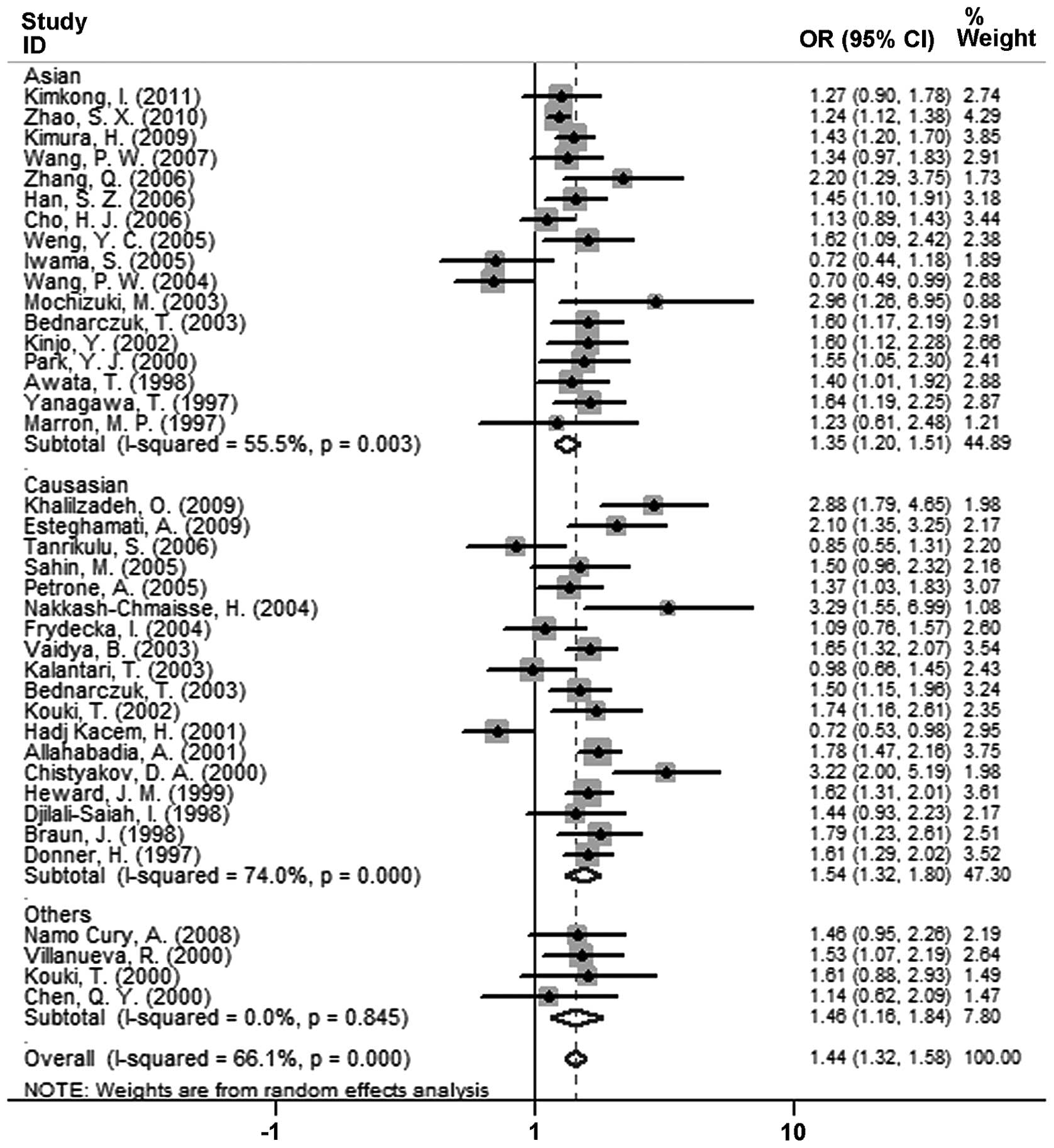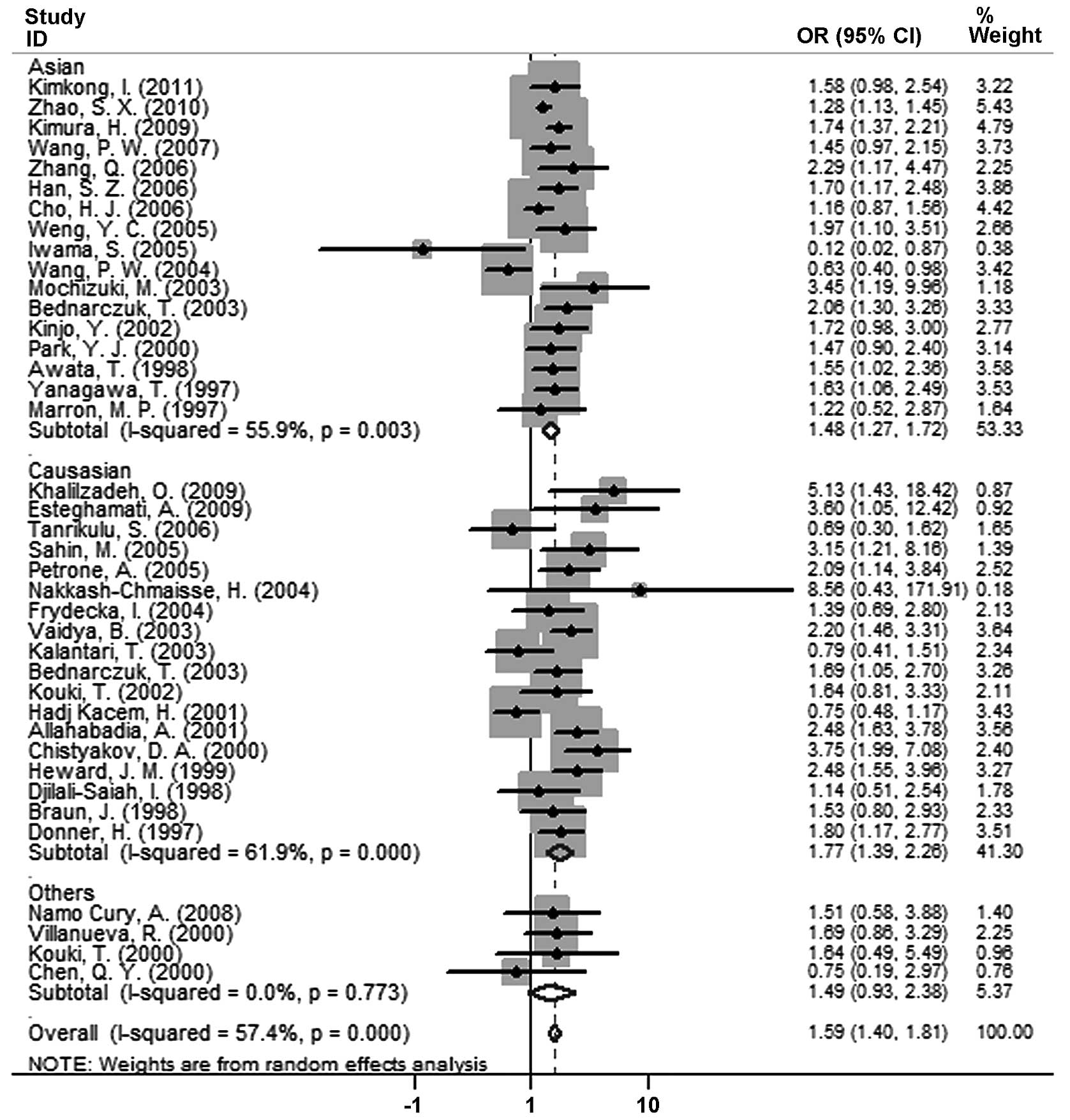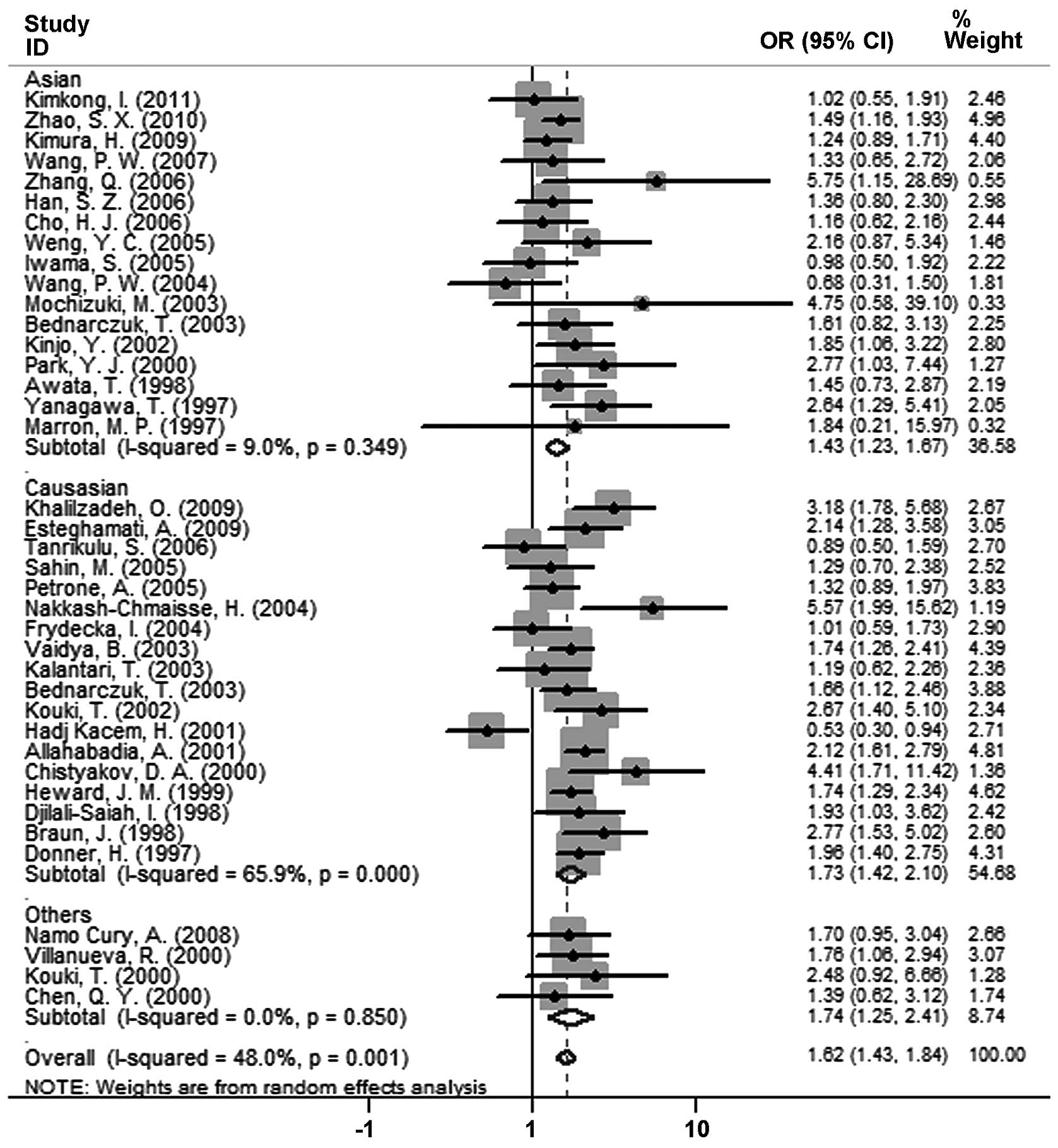Graves’ disease (GD) is one of the autoimmune
thyroid diseases (AITDs) which affect 5% of the general population
(1). GD is an autoimmune
antibody-mediated, thyroid-specific autoimmune disease which causes
thyroid gland tumefaction. GD patients make antibodies to the
thyroid-stimulating hormone receptor leading to hyperthyroidism.
People of Western countries (∼1.2%) and 0.25–1.09% of people of
China are afflicted with GD (2,3).
Although environmental factors, such as infection (4) and stress, are very important in the
process of Graves’ disease in susceptible individuals, one study in
twins revealed that ∼80% of the predisposition to GD is due to
genetic factors (5). Several
genetic loci have been implicated in the susceptibility to this
disease. One of the associated genes is the cytotoxic
T-lymphocyte-associated antigen-4 (CTLA-4) gene which consists of 4
exons and 3 introns. In 1997, Yanagawa et al (6), Marron et al (7) and Donner et al (8) initially reported that there was an
association between CTLA4 and Graves’ disease. The CTLA-4 gene is
located on the long arm of chromosome 2q33 and belongs to the
immunoglobulin superfamily. Since the CTLA-4 protein transmits an
inhibitory signal to T-cells, it has a strong susceptibility in
autoimmunity. One of the CTLA-4 gene polymorphisms is located on
exon 1 +49, which causes a threonine to alanine substitution in
codon 17 (codon 17 T/A). To date, the CTLA-4 +49A/G polymorphism
has been studied in different and numerous groups in humans, and a
potential association with GD has been found in many results
(6–36). However, some results suggest that
there is no association between CTLA-4 +49A/G polymorphism and GD
(37–46). Thus, the results are still
inconsistent. Another problem is that these published studies only
refer to a rather modest sample size that limits their
significance. Utilizing the advantage of meta-analysis, a powerful
method for quantitatively summarizing different study results, we
combined the data for analysis and increased the sample size to a
reasonable level. In this study, we conducted a meta-analysis to
quantitatively assess the effect of the CTLA-4 +49A/G polymorphism
on the risk of GD.
PubMed was searched using the terms ‘CTLA 4’,
‘Graves’ and ‘polymorphism’ or ‘CTLA4’, ‘Graves’ and ‘polymorphism’
or ‘cytotoxic T lymphocyte’, ‘Graves’ and ‘polymorphism’ (the last
search update was on March 11, 2012). Case-control studies
containing available genotype frequencies of 49A/G were chosen.
Additional studies were identified by a manual search of the
references of the original studies.
For the control group of each study, the observed
genotype frequencies of the CTLA-4 +49A/G polymorphism were
assessed for Hardy-Weinberg equilibrium using the χ2
test. The strength of association between the +49A/G polymorphism
of the CTLA-4 gene and GD was assessed by calculating crude odds
ratios (ORs) with 95% confidence intervals (CIs). The pooled ORs
were performed for the additive genetic model (G vs. A), dominant
model (G/G+G/A vs. A/A) and recessive model (G/G vs. G/A+A/A),
respectively. Heterogeneity assumption was checked by a
χ2-based Q-test. A p-value of <0.05 for the Q-test
indicated a lack of heterogeneity among the studies; the summary OR
estimate of each study was calculated by the random effects model
(47,48). The potential for publication bias
was examined by Begg’s test (funnel plot method) and Egger’s linear
regression test (p<0.05 was considered representative of
statistical significance) (49).
All statistical analyses were performed with Stata software
(version 11.0; Stata Corporation, College Station, TX).
We identified 42 case-control studies concerning the
association between the CTLA-4 +49A/G polymorphism and GD, which
included 8,288 GD cases and 9,372 controls. These data were used in
our meta-analysis (Table I). The
distribution of genotypes in the controls of all the studies was in
agreement with Hardy-Weinberg equilibrium.
The results of the association between the CTLA-4
+49A/G polymorphism and GD and the heterogeneity test are shown in
Table II. The overall results
suggest that the variant genotypes were highly associated
(p<0.01) with GD risk in all genetic models [additive model: OR,
1.443; 95% CI, 1.319–1.578; p<0.001 (Fig. 1); recessive model: OR, 1.589; 95%
CI, 1.396–1.808; p<0.001 (Fig.
2); dominant model: OR, 1.621; 95% CI, 1.430–1.837; p<0.001
(Fig. 3)]. Similarly, in subgroup
analyses for ethnicity (Caucasians, Asians), the results were
positive.
Funnel plot and Egger’s test were performed to
estimate the publication bias of studies. The results of Egger’s
test provided statistical evidence for funnel plot symmetry (for
G/G+G/A vs. A/A, p=0.166) (Table
II).
This meta-analysis examined the association of the
CTLA-4 +49A/G polymorphism with GD and included 8,288 GD cases and
9,372 controls. Three studies were eliminated from the total 42
studies due to a p-value of <0.05 (p-value for Hardy-Weinberg
equilibrium in control group) in these studies which induced
significant publication bias. The results of Egger’s test provided
statistical evidence for funnel plot symmetry (for G/G+G/A vs. A/A,
p=0.166). The overall results suggest that the variant genotypes
were highly associated (p<0.01) with GD risk in all genetic
models (additive model: OR, 1.443; 95% CI, 1.319–1.578; p<0.001;
recessive model: OR, 1.589; 95% CI, 1.396–1.808; p<0.001;
dominant model: OR, 1.621; 95% CI, 1.430–1.837; p<0.001).
Similarly, in subgroup analyses for ethnicity (Caucasians, Asians),
the results were positive.
GD is a disease with significant clinical
consequences. The mechanism of GD is still relatively unknown.
Although environmental factors, such as infection (4) and stress, are important in the
process of Graves’ disease in susceptible individuals, one study in
twins suggests that ∼80% of the predisposition to GD is due to
genetic factors (5). Single
nucleotide polymorphisms (SNPs) can be used as a tool for
investigating genetic variations and disease susceptibility. GD is
an autoimmune antibody-mediated, thyroid-specific autoimmune
disease. The CTLA-4 protein can transmit an inhibitory signal to
T-cells and has a strong susceptibility in autoimmunity. CTLA-4
protein has recently been described as a gatekeeper of conjugation
timing and reduced conjugation may protect against prolonged
contact periods of cytotoxic T lymphocytes with autoantigen-defined
targets (50). It has been in the
centre of attention for its key role in autoimmunity. The +49A/G
polymorphism is one of the CTLA-4 three forms of polymorphisms. To
date, a multitude of different studies were carried out concerning
the association between the CTLA-4 +49A/G polymorphism and GD, but
the results are inconsistent. In many studies (6–36)
the results are positive, however in others (37–46)
the results are negative.
This meta-analysis revealed a highly significant
(p<0.01) association between the CTLA-4 +49A/G polymorphism and
GD risk, in both Asian and Caucasian subgroups. In conclusion, this
meta-analysis suggests that the CTLA-4 +49A/G polymorphism is
potentially associated with the risk of GD among Caucasians and
Asians. Future, well-designed, large scale studies are necessary to
validate this association in different populations.
This work was financially supported by
the National Science Foundation of China (nos. 30960152, 30871232,
31170735), the Nature Science Foundation of Yunnan Province (no.
2008C043M) and the Fund of State Key Laboratory of Genetics
Resources and Evolution (no. GREKF10-07).
|
1.
|
Wang C and Crapo LM: The epidemiology of
thyroid disease and implications for screening. Endocrinol Metab
Clin North Am. 26:189–218. 1997. View Article : Google Scholar : PubMed/NCBI
|
|
2.
|
Hollowell JG, Staehling NW, Flanders WD,
Hannon WH, Gunter EW, Spencer CA and Braverman LE: Serum TSH, T(4),
and thyroid antibodies in the United States population (1988 to
1994): National Health and Nutrition Examination Survey (NHANES
III). J Clin Endocrinol Metab. 87:489–499. 2002. View Article : Google Scholar : PubMed/NCBI
|
|
3.
|
Chen XWW, Chen GL, Zhang KZ, Zhang FL, et
al: The effect of salt iodization for 10 years on the prevalences
of endemic goiter and hyperthyroidism. Chin J Endocrinol Metab.
18:342–344. 2000.
|
|
4.
|
Onodera T and Awaya A: Anti-thyroglobulin
antibodies induced with recombinant reovirus infection in BALB/c
mice. Immunology. 71:581–585. 1990.PubMed/NCBI
|
|
5.
|
Brix TH, Kyvik KO, Christensen K and
Hegedus L: Evidence for a major role of heredity in Graves’
disease: a population-based study of two Danish twin cohorts. J
Clin Endocrinol Metab. 86:930–934. 2001.PubMed/NCBI
|
|
6.
|
Yanagawa T, Taniyama M, Enomoto S, Gomi K,
Maruyama H, Ban Y and Saruta T: CTLA4 gene polymorphism confers
susceptibility to Graves’ disease in Japanese. Thyroid. 7:843–846.
1997.
|
|
7.
|
Marron MP, Raffel LJ, Garchon HJ, et al:
Insulin-dependent diabetes mellitus (IDDM) is associated with CTLA4
polymorphisms in multiple ethnic groups. Hum Mol Genet.
6:1275–1282. 1997. View Article : Google Scholar : PubMed/NCBI
|
|
8.
|
Donner H, Rau H, Walfish PG, et al: CTLA4
alanine-17 confers genetic susceptibility to Graves’ disease and to
type 1 diabetes mellitus. J Clin Endocrinol Metab. 82:143–146.
1997.
|
|
9.
|
Veeramuthumari P, Isabel W and Kannan K: A
Study on the level of T(3), T(4), TSH and the association of A/G
polymorphism with CTLA-4 gene in Graves’ hyperthyroidism among
South Indian population. Ind J Clin Biochem. 26:66–69.
2011.PubMed/NCBI
|
|
10.
|
Zhao SX, Pan CM, Cao HM, et al:
Association of the CTLA4 gene with Graves’ disease in the Chinese
Han population. PloS One. 5:e98212010.
|
|
11.
|
Kimura H, Kato Y, Shimizu S, Takano K and
Sato K: Association of polymorphism at position 49 in exon 1 of the
cytotoxic T-lymphocyte-associated factor 4 gene with Graves’
disease refractory to medical treatment, but not with
amiodarone-associated thyroid dysfunction. Thyroid. 19:975–981.
2009.
|
|
12.
|
Khalilzadeh O, Mojazi Amiri H, Tahvildari
M, et al: Pretibial myxedema is associated with polymorphism in
exon 1 of CTLA-4 gene in patients with Graves’ ophthalmopathy. Arch
Dermatol Res. 301:719–723. 2009.PubMed/NCBI
|
|
13.
|
Esteghamati A, Khalilzadeh O, Mobarra Z,
et al: Association of CTLA-4 gene polymorphism with Graves’ disease
and ophthalmopathy in Iranian patients. Eur J Intern Med.
20:424–428. 2009.
|
|
14.
|
Chong KK, Chiang SW, Wong GW, et al:
Association of CTLA-4 and IL-13 gene polymorphisms with Graves’
disease and ophthalmopathy in Chinese children. Invest Ophthalmol
Vis Sci. 49:2409–2415. 2008.PubMed/NCBI
|
|
15.
|
Wang PW, Chen IY, Liu RT, Hsieh CJ, Hsi E
and Juo SH: Cytotoxic T lymphocyte-associated molecule-4 gene
polymorphism and hyperthyroid Graves’ disease relapse after
antithyroid drug withdrawal: a follow-up study. J Clin Endocrinol
Metab. 92:2513–2518. 2007.PubMed/NCBI
|
|
16.
|
Zhang Q, Yang YM and Lv XY: Association of
Graves’ disease and Graves’ ophthalmopathy with the polymorphisms
in promoter and exon 1 of cytotoxic T lymphocyte associated
antigen-4 gene. J Zhejiang Univ Sci B. 7:887–891. 2006.
|
|
17.
|
Tanrikulu S, Erbil Y, Ademoglu E, et al:
The predictive value of CTLA-4 and Tg polymorphisms in the
recurrence of Graves’ disease after antithyroid withdrawal.
Endocrine. 30:377–381. 2006.PubMed/NCBI
|
|
18.
|
Han SZ, Zhang SH, Li R, Zhang WY and Li Y:
The common −318C/T polymorphism in the promoter region of CTLA4
gene is associated with reduced risk of ophthalmopathy in Chinese
Graves’ patients. Int J Immunogenet. 33:281–287. 2006.
|
|
19.
|
Sahin M, Erdogan MF and Erdogan G:
Cytotoxic T lymphocyte-associated molecule-4 polymorphisms in
Turkish Graves’ disease patients and association with probability
of remission after antithyroid therapy. Eur J Intern Med.
16:352–355. 2005.PubMed/NCBI
|
|
20.
|
Petrone A, Giorgi G, Galgani A, et al:
CT60 single nucleotide polymorphisms of the cytotoxic
T-lymphocyte-associated antigen-4 gene region is associated with
Graves’ disease in an Italian population. Thyroid. 15:232–238.
2005.
|
|
21.
|
Wang PW, Liu RT, Juo SH, et al: Cytotoxic
T lymphocyte-associated molecule-4 polymorphism and relapse of
Graves’ hyperthyroidism after antithyroid withdrawal. J Clin
Endocrinol Metab. 89:169–173. 2004.
|
|
22.
|
Nakkash-Chmaisse H, Makki RF, Abdelhamid
E, Fakhoury H, Salti NN and Salti I: CTLA-4 gene polymorphism and
its association with Graves’ disease in the Lebanese population.
Eur J Immunogenet. 31:141–143. 2004.
|
|
23.
|
Vaidya B, Oakes EJ, Imrie H, Dickinson AJ,
Perros P, Kendall-Taylor P and Pearce SH: CTLA4 gene and Graves’
disease: association of Graves’ disease with the CTLA4 exon 1 and
intron 1 polymorphisms, but not with the promoter polymorphism.
Clin Endocrinol. 58:732–735. 2003.
|
|
24.
|
Mochizuki M, Amemiya S, Kobayashi K, et
al: Association of the CTLA-4 gene 49A/G polymorphism with type 1
diabetes and autoimmune thyroid disease in Japanese children.
Diabetes Care. 26:843–847. 2003. View Article : Google Scholar : PubMed/NCBI
|
|
25.
|
Kalantari T, Mostafavi H, Pezeshki AM,
Farjadian S, Doroudchi M, Yeganeh F and Ghaderi A: Exon-1
polymorphism of ctla-4 gene in Iranian patients with Graves’
disease. Autoimmunity. 36:313–316. 2003.
|
|
26.
|
Bednarczuk T, Hiromatsu Y, Fukutani T,
Jazdzewski K, Miskiewicz P, Osikowska M and Nauman J: Association
of cytotoxic T-lymphocyte-associated antigen-4 (CTLA-4) gene
polymorphism and non-genetic factors with Graves’ ophthalmopathy in
European and Japanese populations. European J Endocrinol.
148:13–18. 2003.PubMed/NCBI
|
|
27.
|
Yung E, Cheng PS, Fok TF and Wong GW:
CTLA-4 gene A-G polymorphism and childhood Graves’ disease. Clin
Endocrinol. 56:649–653. 2002.
|
|
28.
|
Kouki T, Gardine CA, Yanagawa T and
Degroot LJ: Relation of three polymorphisms of the CTLA-4 gene in
patients with Graves’ disease. J Endocrinol Invest. 25:208–213.
2002.PubMed/NCBI
|
|
29.
|
Kinjo Y, Takasu N, Komiya I, et al:
Remission of Graves’ hyperthyroidism and A/G polymorphism at
position 49 in exon 1 of cytotoxic T lymphocyte-associated
molecule-4 gene. J Clin Endocrinol Metab. 87:2593–2596. 2002.
|
|
30.
|
Hadj Kacem H, Bellassoued M,
Bougacha-Elleuch N, Abid M and Ayadi H: CTLA-4 gene polymorphisms
in Tunisian patients with Graves’ disease. Clin Immunol.
101:361–365. 2001.PubMed/NCBI
|
|
31.
|
Park YJ, Chung HK, Park DJ, Kim WB, Kim
SW, Koh JJ and Cho BY: Polymorphism in the promoter and exon 1 of
the cytotoxic T lymphocyte antigen-4 gene associated with
autoimmune thyroid disease in Koreans. Thyroid. 10:453–459.
2000.PubMed/NCBI
|
|
32.
|
Kouki T, Sawai Y, Gardine CA, Fisfalen ME,
Alegre ML and DeGroot LJ: CTLA-4 gene polymorphism at position 49
in exon 1 reduces the inhibitory function of CTLA-4 and contributes
to the pathogenesis of Graves’ disease. J Immunol. 165:6606–6611.
2000.PubMed/NCBI
|
|
33.
|
Chistyakov DA, Savost’anov KV, Turakulov
RI, et al: Complex association analysis of Graves disease using a
set of polymorphic markers. Mol Genet Metab. 70:214–218. 2000.
View Article : Google Scholar : PubMed/NCBI
|
|
34.
|
Heward JM, Allahabadia A, Armitage M, et
al: The development of Graves’ disease and the CTLA-4 gene on
chromosome 2q33. J Clin Endocrinol Metab. 84:2398–2401. 1999.
|
|
35.
|
Braun J, Donner H, Siegmund T, Walfish PG,
Usadel KH and Badenhoop K: CTLA-4 promoter variants in patients
with Graves’ disease and Hashimoto’s thyroiditis. Tissue Antigens.
51:563–566. 1998.
|
|
36.
|
Awata T, Kurihara S, Iitaka M, et al:
Association of CTLA-4 gene A-G polymorphism (IDDM12 locus) with
acute-onset and insulin-depleted IDDM as well as autoimmune thyroid
disease (Graves’ disease and Hashimoto’s thyroiditis) in the
Japanese population. Diabetes. 47:128–129. 1998.PubMed/NCBI
|
|
37.
|
Kimkong I, Nakkuntod J, Sae-Ngow S,
Snabboon T, Avihingsanon Y and Hirankarn N: Association between
CTLA-4 polymorphisms and the susceptibility to systemic lupus
erythematosus and Graves’ disease in Thai population. Asian Pac J
Allergy Immunol. 29:229–235. 2011.
|
|
38.
|
Namo Cury A, Longui CA, Kochi C, et al:
Graves’ disease in Brazilian children and adults: lack of genetic
association with CTLA-4 +49A>G polymorphism. Horm Res. 70:36–41.
2008.
|
|
39.
|
Cho HJ, Chung JH, Kim IS, Kim HJ, Cho SH,
Ki CS and Kim JW: Lack of a genetic association between the CTLA-4
gene and Graves’ disease in Koreans. Thyroid. 16:237–241. 2006.
|
|
40.
|
Weng YC, Wu MJ and Lin WS: CT60 single
nucleotide polymorphism of the CTLA-4 gene is associated with
susceptibility to Graves’ disease in the Taiwanese population. Ann
Clin Lab Sci. 35:259–264. 2005.
|
|
41.
|
Iwama S, Ikezaki A, Kikuoka N, et al:
Association of HLA-DR, -DQ genotype and CTLA-4 gene polymorphism
with Graves’ disease in Japanese children. Horm Res. 63:55–60.
2005.PubMed/NCBI
|
|
42.
|
Frydecka I, Daroszewski J, Suwalska K, et
al: CTLA-4 (CD152) gene polymorphism at position 49 in exon 1 in
Graves’ disease in a Polish population of the Lower Silesian
region. Arch Immunol Ther Exp (Warsz). 52:369–374. 2004.
|
|
43.
|
Allahabadia A, Heward JM, Nithiyananthan
R, et al: MHC class II region, CTLA4 gene, and ophthalmopathy in
patients with Graves’ disease. Lancet. 358:984–985. 2001.PubMed/NCBI
|
|
44.
|
Villanueva R, Inzerillo AM, Tomer Y, et
al: Limited genetic susceptibility to severe Graves’
ophthalmopathy: no role for CTLA-4 but evidence for an
environmental etiology. Thyroid. 10:791–798. 2000.
|
|
45.
|
Chen QY, Nadell D, Zhang XY, et al: The
human leukocyte antigen HLA
DRB3*020/DQA1*0501 haplotype is associated
with Graves’ disease in African Americans. J Clin Endocrinol Metab.
85:1545–1549. 2000.PubMed/NCBI
|
|
46.
|
Djilali-Saiah I, Larger E,
Harfouch-Hammoud E, et al: No major role for the CTLA-4 gene in the
association of autoimmune thyroid disease with IDDM. Diabetes.
47:125–127. 1998. View Article : Google Scholar : PubMed/NCBI
|
|
47.
|
DerSimonian R and Laird N: Meta-analysis
in clinical trials. Control Clin Trials. 7:177–188. 1986.
View Article : Google Scholar : PubMed/NCBI
|
|
48.
|
Mantel N and Haenszel W: Statistical
aspects of the analysis of data from retrospective studies of
disease. J Natl Cancer Inst. 22:719–748. 1959.PubMed/NCBI
|
|
49.
|
Egger M, Davey Smith G, Schneider M and
Minder C: Bias in meta-analysis detected by a simple, graphical
test. BMJ. 315:629–634. 1997. View Article : Google Scholar : PubMed/NCBI
|
|
50.
|
Schneider H, Downey J, Smith A, et al:
Reversal of the TCR stop signal by CTLA-4. Science. 313:1972–1975.
2006. View Article : Google Scholar : PubMed/NCBI
|

















